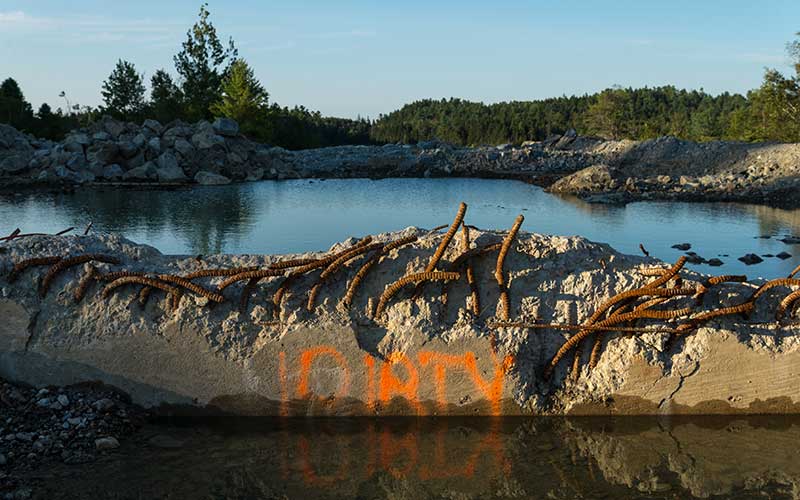
Callahan Mine in Maine is one of thousands of hazardous waste sites and chemical facilities across New England unprepared for the impacts of climate change. Photo: OliverRich/CC-BY-NC-ND-2.0
For decades, operations at the Callahan Mine in Brooksville, Maine, contaminated the site with arsenic, lead, thallium, and polychlorinated biphenyls (PCBs). That landed the mine on the federal government “Superfund” list of some of the country’s most contaminated sites.
Though the mine closed in 1972, efforts to clean it up only began in 2004. That clean-up was still going on when, in 2019, the U.S. Government Accountability Office (GAO) found that the site is vulnerable to climate impacts. However, the EPA’s April 2021 review of clean-up measures at the mine makes no mention of those climate risks.
Callahan Mine is just one of the thousands of hazardous waste sites and chemical facilities across New England unprepared for the impacts of climate change. The failure of regulators to require such preparation leaves the health of our communities and our environment in jeopardy.
Individual site owners and operators could already face legal liability for failing to adapt to climate change. But we also need leadership from the Environmental Protection Agency (EPA) on clear standards for climate risk in the clean-up and monitoring of these sites to keep our communities safe. The time to act is now – before climate impacts worsen.
You can find out if your community is at risk. CLF mapped the worst of these facilities and their climate-related impacts. Together, we can push regulators – starting with the EPA – to step up and consistently plan for the climate impacts we know are coming.
What’s the Problem?
New England’s long history of industrial activity makes it home to many sites contaminated by toxic pollution – even if those facilities no longer operate. At the same time, many active facilities – from landfills to chemical plants – still generate hazardous waste today.
State and/or federal government regulate both types of sites. However, despite laws that dictate how these sites – and their waste – should be handled, regulators have not held them accountable for their failure to prepare for the climate impacts.
We already know the dangers climate change poses to these facilities. Flooding of hazardous sites can dislodge contaminants and spread them into communities and the environment. Chemicals mix together in the floodwater, which creates a “toxic stew” as they blend with existing contaminants in soil and the waterways. Scientists still don’t know the full consequences to our health of exposure to this stew.
During and after Hurricane Harvey in 2017, Houston residents were forced to swim through floodwater that contained chemicals from at least 10 oil and gas refineries, 500 chemical plants, and 12 Superfund sites. During Hurricane Ida in September of this year, Louisiana officials could not even measure the extent of the toxic exposures. The storm had knocked out the power needed for monitoring equipment.
Climate change is making this danger more dire – and New England is not immune.
How New England Hazardous Sites at Risk from Climate Change?
Climate change is causing major shifts in weather patterns, including more frequent and severe storms, floods, and temperature extremes. While flooding is the most prominent risk to these facilities, other climate impacts pose dangers as well. Extreme heat can damage the infrastructure – like caps that sit over contaminated soil – used at these sites to protect surrounding communities. Wildfires can also damage this infrastructure and spew toxic chemicals into the air.
These impacts will worsen in the years to come. Across New England, thousands of sites – both active facilities and those with historic contamination – are unprepared for this climate fallout. Even cleaned-up sites remain a risk. Yet despite these known dangers, federal and state regulators are leaving us vulnerable to disaster. This is because the EPA does not consistently integrate information about climate change into its assessments of the adequacy or longevity of the clean-up techniques it uses.
What Kinds of Sites Are We Talking About?
CLF analyzed the risk these hazardous sites pose to communities across New England. We focused on three types of sites:
- Contaminated sites regulated under the federal Superfund law. These are the worst of the worst. They fall onto a national priority list based on known releases or threatened releases of hazardous substances, pollutants, or contaminants. Some of these sites have been cleaned up while others are in process. New England is home to 123 Superfund sites currently.
- Active operations where hazardous waste is currently generated and disposed of. We looked specifically at sites regulated under a law called the Resource Conservation and Recovery Act. This law gives the federal government the authority to regulate the generation of waste at a site and its transportation, treatment, storage, and disposal. We analyzed 1,947 of these sites across New England.
- Landfills – both closed and active operations. While regulated under the Resource Conservation and Recovery Act, landfills pose acute risks to human health and safety because they inevitably leak toxic substances called leachate. “Liners” under landfills are supposed to keep toxic substances contained, but these liners fail over time. Even worse, some landfills – especially older, closed facilities – have an inadequate or no liner at all.
Hazardous Waste Is an Environmental Justice Issue
Low-income communities and communities of color are disproportionately located near hazardous sites across New England and the U.S. due to decades of environmental racism and injustice. As a result, they face higher burdens from air and other types of pollution, which directly affect their health.
These communities also experience greater impacts from climate change, from heat extremes to poorer air quality. In an emergency, they are least likely to be able to evacuate. They also face structural barriers in accessing help to recover from a disaster.
Our analysis includes data on these and other markers of vulnerability to determine which counties across New England are at the highest risk from hazardous sites.
How Can You Help Protect Your Community and Environment?
Not enough is being done to protect New Englanders from toxic releases caused by climate change. The EPA has acknowledged the risk climate change poses to toxic sites. The agency also has issued guidance indicating that it may consider these risks when designing and approving clean-ups of contaminated sites.
Guidance is not enough. The EPA must act now to develop and enforce binding requirements for contaminated sites that account for climate change impacts. We must do everything we can today to reduce the risk from hazardous areas unprepared for climate impacts.
Take a look at CLF’s interactive map to see how at risk your community is, and then demand that the EPA does all it can to protect it. Click here to send an email to the EPA Region I administrator calling for urgent action on hazardous sites and climate change risk




